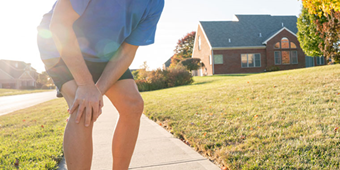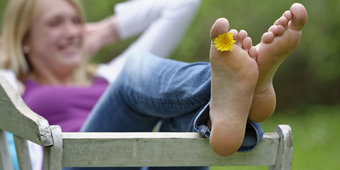Osteoarthritis Most Common, Debilitating Form Of Arthritis

Find Your Perfect Match
Answer a few questions and we'll provide you with a list of primary care providers that best fit your needs.
Because of osteoarthritis, up to 27 million Americans have difficulty doing simple activities, such as putting on bed sheets, holding a pencil, climbing stairs, or driving a car, according to the Arthritis Foundation (AF).
Also known as degenerative joint disease, osteoarthritis occurs when the cartilage – the firm, rubbery material around a person’s joints – breaks down and no longer provides the cushion needed between the bone to help keep the joints moving smoothly.
“Osteoarthritis is the loss of cartilage on the end of the bone,” says orthopedic surgeon James Klosterman. “This is important for patients to understand because often there is a misconception that if we simply went in and scraped something out, that their problem would go away. But you can’t remove something that is not there already. We are talking about the loss of cartilage – it’s gone. And as a result, you’re rubbing bone on bone.”
Without a smooth surface or a cushion between the bones, osteoarthritis often starts to cause pain, according to the AF.
Osteoarthritis is the most common chronic condition of the joints, and it most often occurs in the knees, hips, lower back, neck, small joints of the fingers, and the bases of the thumb and big toe.
Symptoms of osteoarthritis typically build over time rather than coming on suddenly. The most common symptoms of osteoarthritis are pain and stiffness, especially first thing in the morning or after resting.
Joints affected by osteoarthritis often get swollen, most often after a person participates in extended activity.
Osteoarthritis affects more than one-third of adults over 65, according to the National Institutes of Health and is oftentimes seen as an age-related disease.
However, it also can affect adults at any age, says Dr. Klosterman. Risk factors include family history, genetics, disease, and excessive use of joints in sports at a young age.
“Injury prevention is key,” Dr. Klosterman says. “Staying healthy, maintaining a healthy weight, managing your lifestyle so that you don’t increase your predisposition to develop osteoarthritis is critical because once you get it, once you develop the symptoms, history tells us that progression is its natural course.”
Dr. Klosterman recommends the following steps to help prevent osteoarthritis:
- Care for injuries. If you have a traumatic joint injury, it is important to seek treatment for it. Injuries that do not heal properly can significantly affect the development of osteoarthritis in the future.
- Make lifestyle changes. There is a direct link between smoking, poor nutrition, and joint pain. It’s important to take steps to quit smoking and improve your diet.
- Maintain a healthy weight. Joints are seriously affected by obesity. Once people take steps to return to a healthy weight, many times they find they no longer have joint pain. “It’s about what you eat, how you eat, and what you put into your body,” Dr. Klosterman says. “If you follow a good plan, then you will naturally drop weight.”
- Stay active. Regular exercise is important to prevent osteoporosis, but it is important to listen to your body if pain starts. Exercise that causes joint pain should be re-evaluated and modified to lower-impact activities.
Find Your Perfect Match
Answer a few questions and we'll provide you with a list of primary care providers that best fit your needs.
Source: James Klosterman, MD, Premier Orthopedics; Arthritis Foundation; National Institutes of Health





